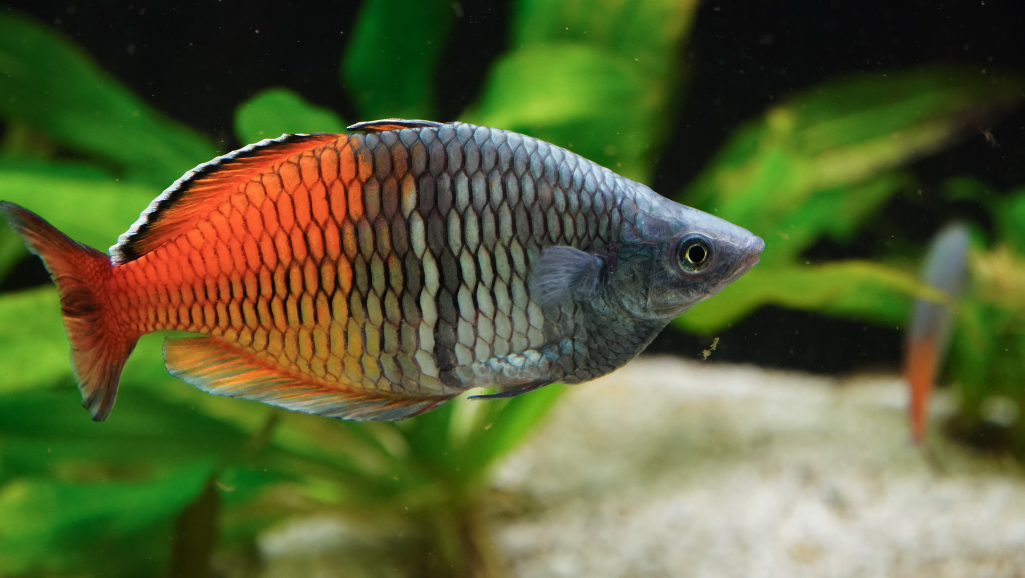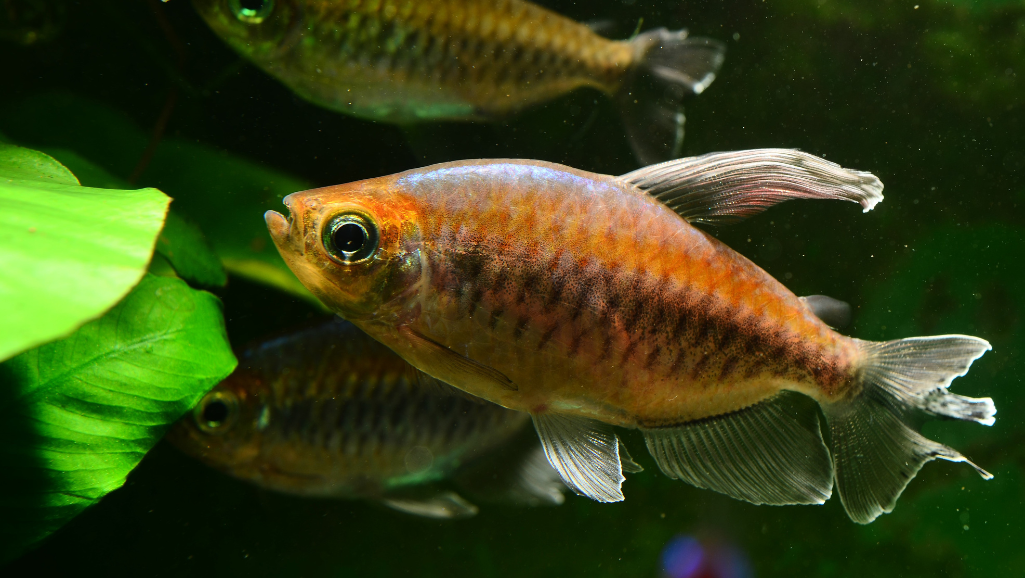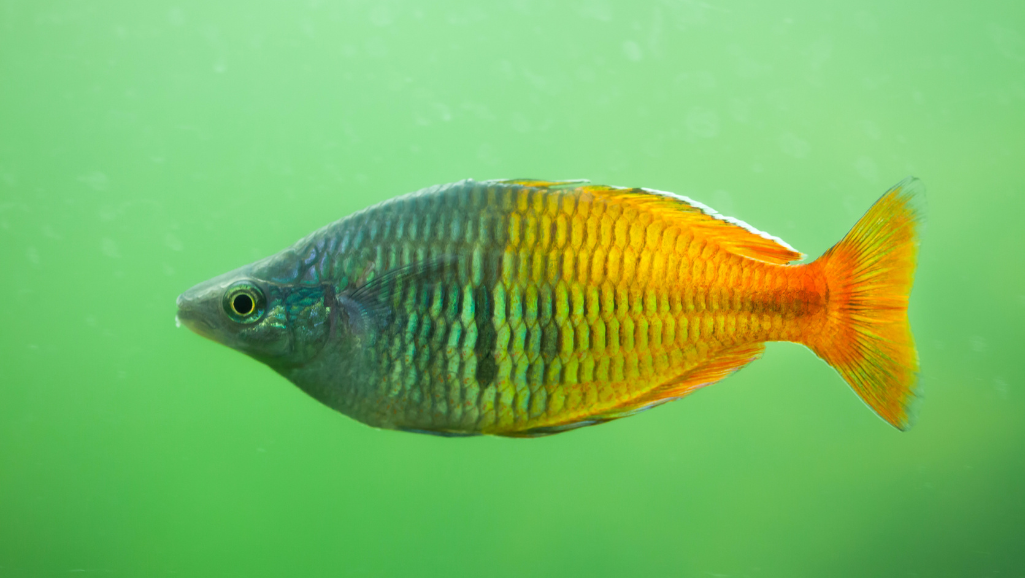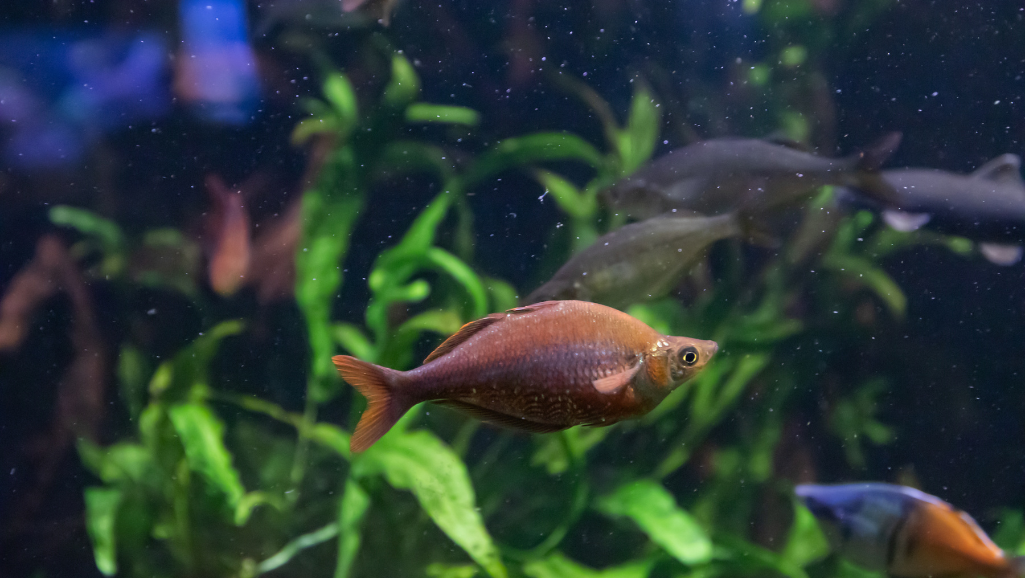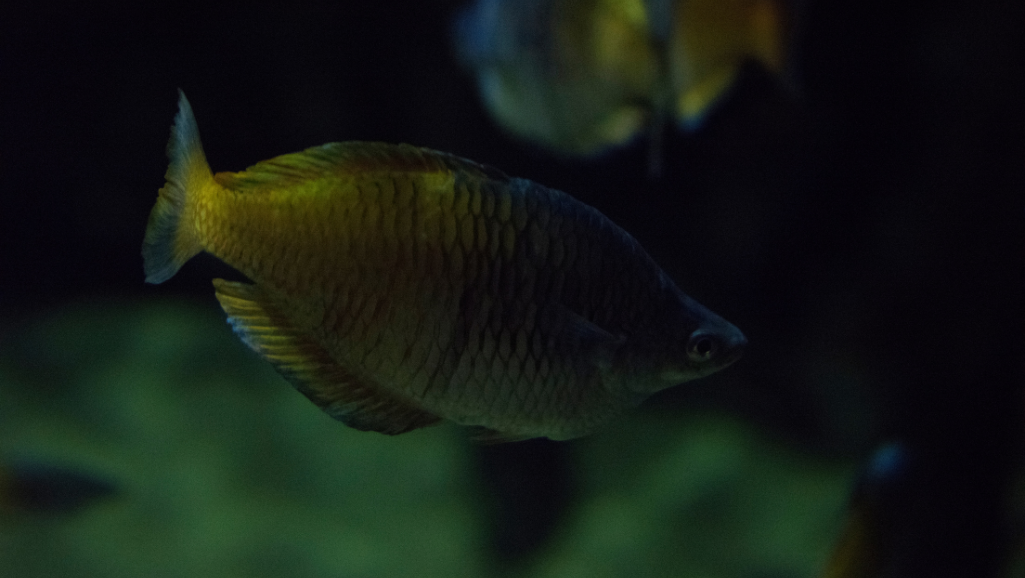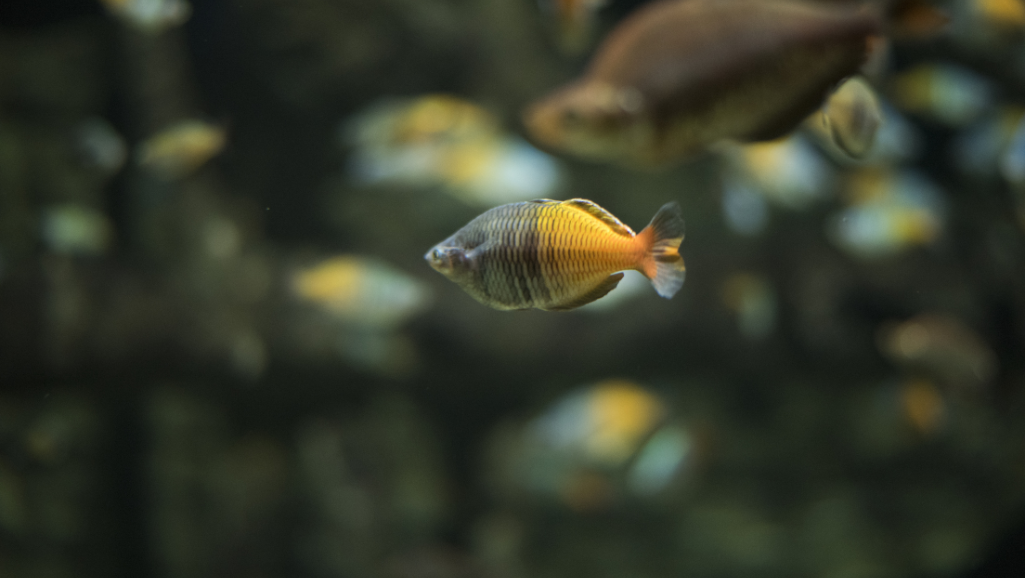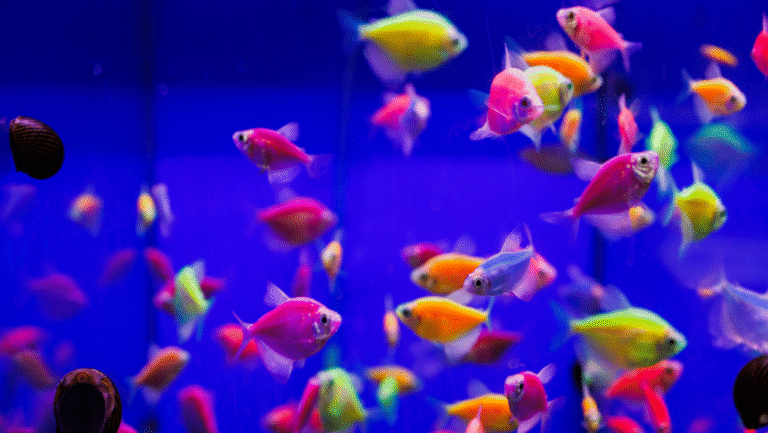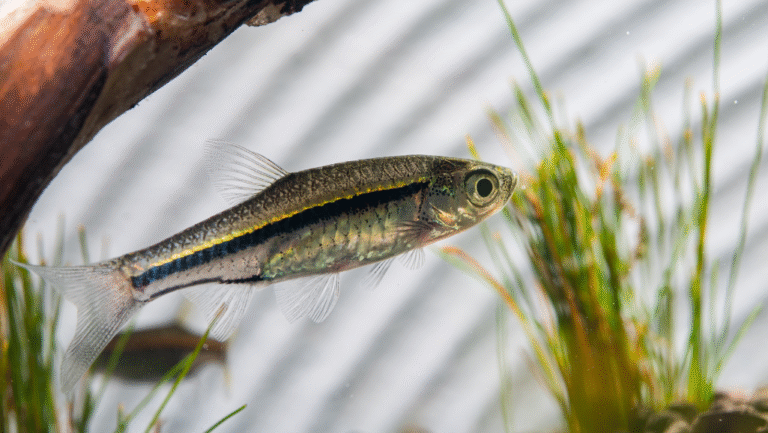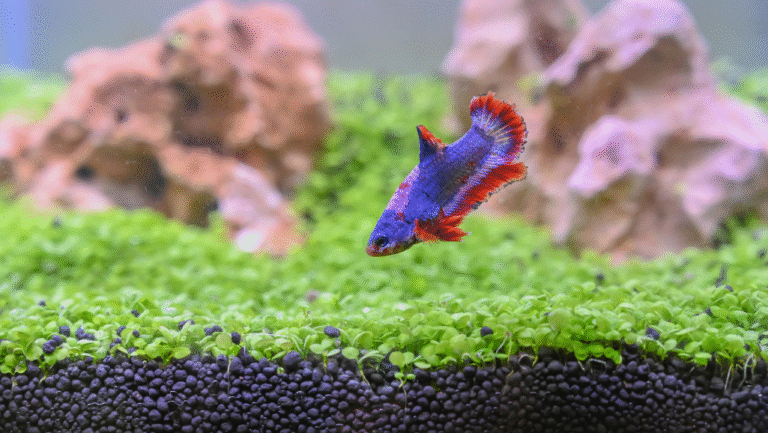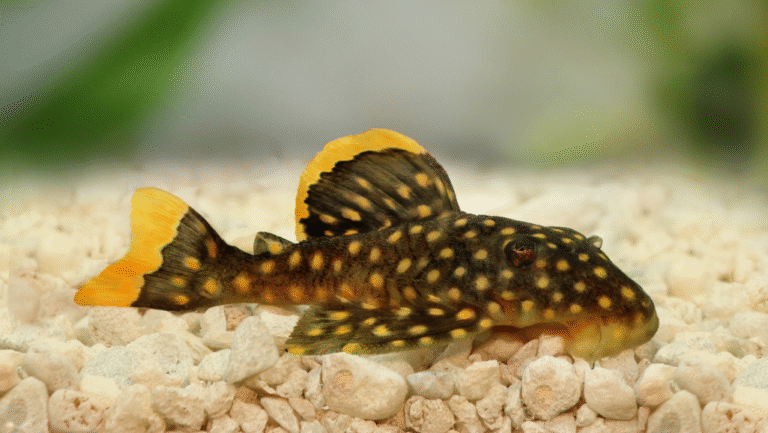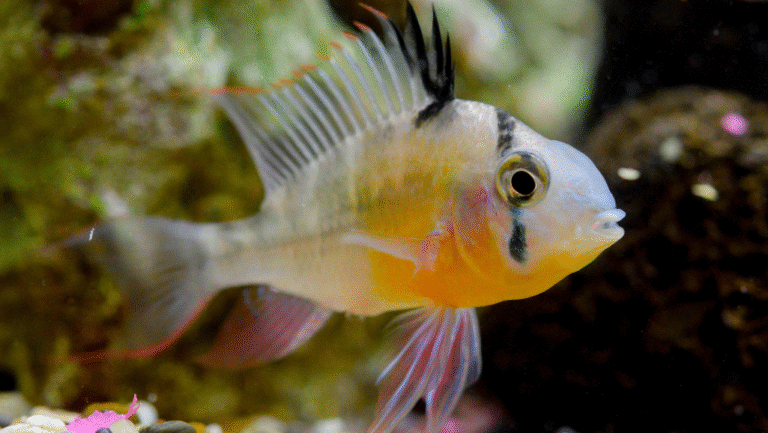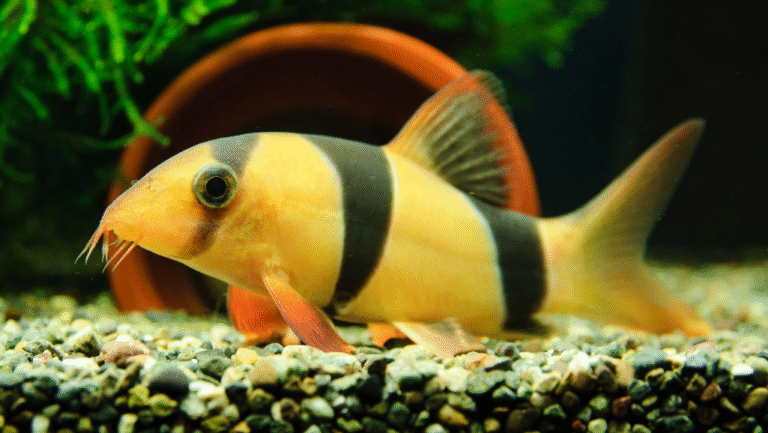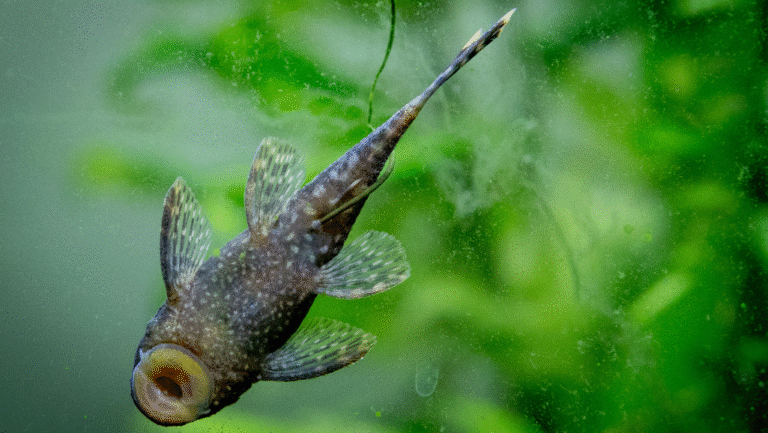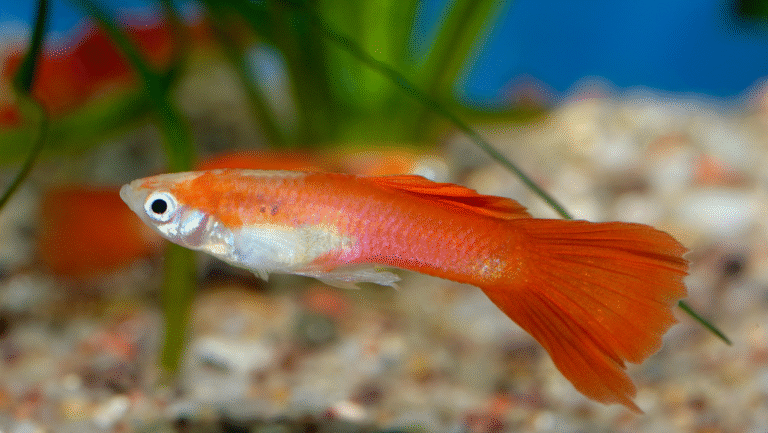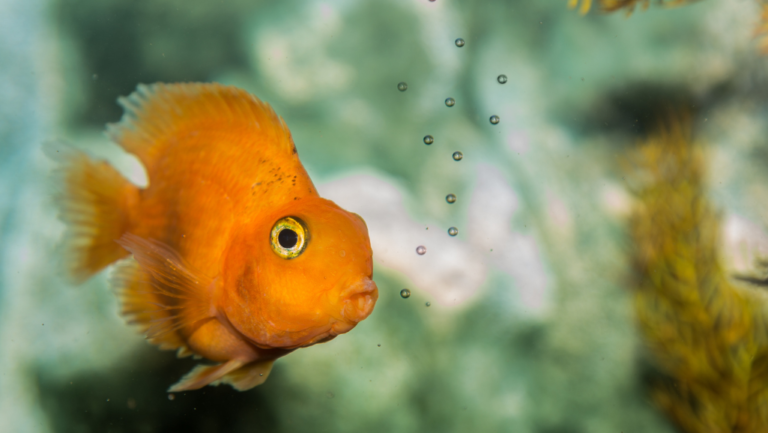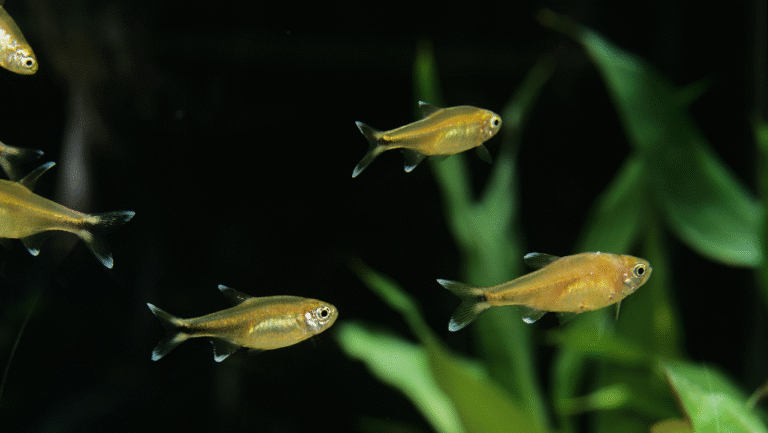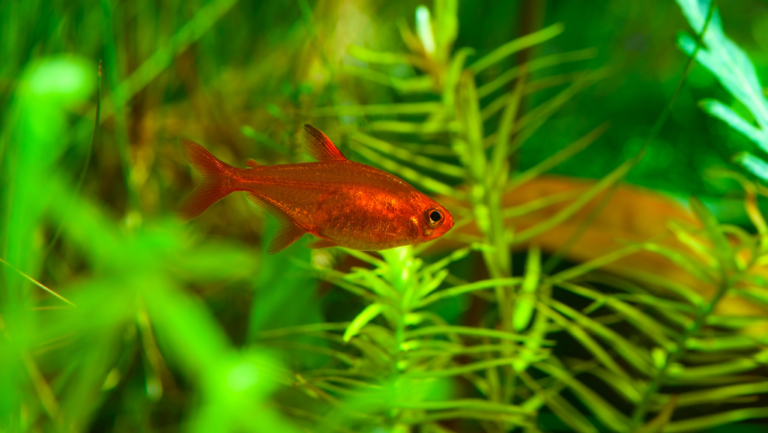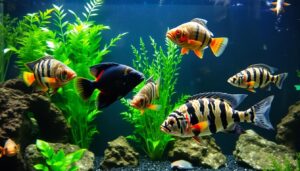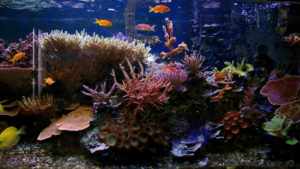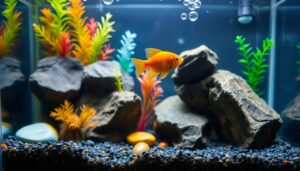Meet a shimmering species that brings river light into your home. This lively fish thrives in clear, shaded streams and lower river reaches, and it shows its best colors when kept as a school.
In nature, groups move in sync through tannin-stained waters and soft, acidic flows. In the aquarium, the right footprint, dense planting, driftwood, and spotless, oxygen-rich water unlock peak color and vigor.
Learn the scientific order and true name to avoid trade mix-ups. Understand ideal temperature, pH, and weekly water changes so life span and coloration stay strong. Thoughtful stocking and habitat mimicry turn a tank into a living ribbon of motion.
Key Takeaways
- Keep them in lively schools to reveal natural behavior and color.
- Provide a spacious tank (120 x 30 cm or larger) and rich planting.
- Maintain pristine, oxygen-rich water with weekly changes of 30–50%.
- Mimic their shaded, soft-water habitat for best health and display.
- Know the species’ order and name to ensure proper care and sourcing.
Set Your Vision: A How-To Guide to a Thriving Madagascar Rainbowfish Aquarium
Picture a long, planted aquarium where a lively school moves with the calm rhythm of shaded streams. Start with a 120 x 30 cm base or larger so active fish can cruise and display.
Focus on stable conditions: strong oxygenation, clean soft water, and steady parameters. Use gentle flow, reliable filtration, and weekly 30–50% water changes to keep chemistry even.
Build an aquascape of dense plants, driftwood, floating cover, and leaf litter. These elements reduce stress and let the species behave naturally in groups of 8–10+.
Feeding blends staples and treats: quality flakes or micro-granules daily, with regular live or frozen Daphnia, Artemia, and bloodworms for condition and breeding readiness.
- Prioritize length over height for movement.
- Plan care routines: testing, water changes, and filter upkeep.
- Avoid mixing with other Bedotia to prevent hybrid risks.
Keep your vision flexible: observe, adjust, and refine so the tank matures into a living vignette of freshwater nature and joy.
Quick-Start Checklist: From Empty Tank to Active School
Begin with the essentials: confirm a 120 x 30 cm (4 ft) footprint or larger, reliable filtration, and dechlorinated water. Set the temperature to a stable 22–25°C for best results and verify key water parameters before any stocking.
Lay a natural hardscape of driftwood and leaf litter, and plant densely. Add floating cover to diffuse light and create microhabitats that lower stress and improve oxygen.
“A well-planned start makes healthy, colorful schools possible.”
- Cycle fully; introduce fish only when ammonia and nitrite read zero.
- Stock groups of 8–10+ to reduce hierarchy stress and get lively displays.
- Quarantine newcomers to protect your display and avoid hybrid risks.
- Plan weekly 30–50% water changes to keep conditions spotless and oxygen-rich.
- Feed quality staples: flake or micro-granules daily, and rotate live or frozen foods like Daphnia, Artemia, and bloodworms several times weekly.
- Prepare a simple spawning kit (fine plants or mops). If you find eggs, expect hatch in about 7–10 days and have infusoria ready for fry.
- Log temperature and tests; adjust slowly to avoid shock to adults and growing fry.
- Maintain filter care and surface cleaning to keep dissolved organics low and oxygen high.
Follow this checklist and you’ll move from empty glass to a thriving, colorful school with fewer surprises. Small routines yield big, lasting rewards.
madagascar rainbowfish
A clear ID and origin story guide better husbandry and protect genetic integrity.
Scientific name, origin, and conservation status
Name: Bedotia madagascariensis (described 1903). Its order is Atheriniformes and it belongs to the family Bedotiidae.
The natural range is small streams and lower rivers in the Atsinanana region of eastern Madagascar, including waterways linked by the Canal des Pangalanes.
Note: trade records sometimes misidentify this species as Bedotia geayi. Correct ID matters to avoid hybridization and to follow conservation advice.
Size, lifespan, and temperament at a glance
Expect a modest size: scientific sources list a standard length of 80–100 mm, while hobby reports note up to ~15 cm total length.
The adults are peaceful, schooling fish best kept in groups of 8–10 or more to reduce stress.
- Males are more ornate with distinct fin pigmentation.
- Females show fuller bodies and subtler fins.
- Watch for spawning in planted or mop setups; check for eggs if breeding is intended.
Understand Their World: Natural Habitat and Behavior in Madagascar
Narrow, tree-lined waterways set the stage for much of this species’ daily life. This habitat often means tea-stained, softly flowing streams and calm lower rivers that drain to coastal lakes and lagoons in the Atsinanana range.
Riparian vegetation casts shade and slows flow. Those cues reduce stress and let groups form into schools that can number several dozen.
Clear, shaded streams, rivers, and coastal lakes of the Atsinanana region
Many waters are extremely soft and tannin-rich—true blackwater in places. The Canal des Pangalanes links these pockets, letting seasonal movements connect populations.
Schooling nature: juveniles in shallows, adults in deeper waters
Juveniles hug sheltered margins while adults cruise deeper channels. This life-stage shift keeps the group dynamic intact and helps preserve fins and color.
“Clarity and shade are survival factors — recreate them and you invite natural behavior and calmer displays.”
- Recreate shaded cover to mimic nature.
- Avoid bright, unshaded tanks that favor invasive livebearers.
- Think in terms of rivers and streams when planning flow and sightlines.
This understanding of nature helps you design an aquascape that respects range, behavior, and the needs of the madagascar rainbowfish.
Tank Setup That Mirrors Nature
Design the tank to mirror river corridors so schools can swim with effortless grace.
Start with the right base: choose a 120 x 30 cm or larger footprint so active swimmers have real length and room to form steady schools. Size matters more than height for natural movement.
Aquascape essentials
Lay heavy plants and driftwood roots to create corridors and sight breaks. Add floating vegetation and a thin layer of leaf litter to soften light and release mild tannins.
Flow and filtration
Pick a filtration system that delivers gentle current and high oxygen transfer. Keep water spotless—this species is intolerant of organics and benefits from weekly 30–50% changes.
- Prioritize a long footprint—plenty of open midwater for schooling.
- Zone the layout—open lanes, shaded edges, and thickets for refuge.
- Use fine substrate that won’t trap debris and shows off natural colors.
“Clean, oxygen-rich conditions bring out color and calm behavior.”
These choices build an aquascape that supports behavior and quality of life for the madagascar rainbowfish while inspiring a living, moving display.
Dialing in Water Parameters for Peak Color and Health
Good aquarium color begins with steady, predictable water chemistry. Keep the focus on consistency more than chasing wild extremes. Small, steady gains in clarity and chemistry produce big visual results.
Temperature, pH, hardness and TDS that work
Temperature is best kept near 22–25°C in tanks, though wild waters swing 23–32°C seasonally. Aim for a stable day-to-day temperature to protect metabolism and color.
Native pH can range 4.5–7.5. Favor slightly soft conditions, and keep hardness and TDS modest while accepting natural variation.
Soft, clean freshwater and the role of tannins
Favor clean, soft freshwater. Gentle tannins from botanicals and leaf litter calm fish and deepen tones. These botanicals also support a balanced micro-ecosystem.
Stability strategies: testing cadence and adjustment tips
Test water parameters weekly at consistent times and log trends. When you adjust, change slowly: preconditioned, temperature-matched water and gradual reintroduction protect sensitive fish.
- Weekly 30–50% water changes remove organics and control nitrates.
- Match temperature and chemistry to avoid shock during changes.
- Prioritize pristine, steady conditions over perfect numbers.
“Clear waters and steady chemistry bring out stronger schooling and richer display.”
Stocking Strategy: Groups, Sex Ratios, and Peaceful Tankmates
A thoughtful stocking plan turns a good aquarium into a confident, colorful school. Start by sizing the tank for the whole community, not just one highlight species.
Why 8–10+ and a female-heavy balance work
Build a cohesive school of at least 8–10 individuals so each fish relaxes into safety in numbers. Larger groups show tighter formation and bolder color.
Favor more females than males to reduce chasing and redirect displays toward mating instead of harassment. This balance improves welfare and lowers stress.
Compatible companions and hybrids to avoid
Pick calm midwater tankmates that match pace and conditions: similarly sized rainbowfishes, barbs, characids, peaceful cichlids, and catfishes can work well as dither fish.
Avoid keeping other Bedotia species to prevent unintended hybridization and protect lineage integrity.
- Use aquascape sightlines and shaded zones to diffuse male displays.
- Introduce newcomers slowly and quarantine first to protect your tank.
- Plan stocking so the full community has room to swim and hide.
“Right numbers, thoughtful mates, and a roomy layout produce calmer behavior and brighter displays.”
Feeding for Brilliance: Daily Diets and Color-Boosting Foods
A thoughtful diet unlocks the best hues and energy in your school.
Staples: fine flakes and micro-granules
Anchor daily feeding with a quality flake or micro-granule designed for small midwater fish. These staples supply steady nutrition and are easy to portion.
Live and frozen treats
Rotate live and frozen items such as Daphnia, Artemia, and bloodworms. These foods spark natural foraging, deepen color, and are vital when conditioning adults for eggs and spawning.
Frequency, portions, and water care
Feed small amounts two to three times daily so the school gets plenty without overloading filtration. Watch how fish move to the mid-to-top column and adjust particle size so all mouths get a share.
- Use staples as the base, then add variety several times weekly.
- Clear uneaten food within minutes to protect water quality.
- Boost live offerings briefly when preparing for breeding.
- Match portioning to group size to avoid nutrient spikes.
Tip: Let feeding mirror wild patterns—light, frequent, and varied—to keep color saturated and behavior lively in your aquarium.
Water Quality Maintenance: Routine That Makes Colors Pop
A simple weekly routine keeps water pristine and the school showing its best hues.
Weekly water changes: volumes, technique, and timing
Schedule weekly water changes of 30–50%. Match temperature and dechlorinate replacement water to protect gill health and color intensity.
Vacuum lightly around leaf litter and plants to remove detritus without stripping the biofilm that stabilizes the system. Time maintenance away from major feedings to reduce stress and avoid post-cleaning nutrient spikes.
Filter care, oxygenation, and nitrate control
Service filters on a rotating schedule so beneficial bacteria remain robust while flow stays strong and oxygen-rich. Keep an eye on nitrate; consistent changes and mindful feeding keep levels low and fins flawless.
“Steady routines yield steady results.”
- Track maintenance times and outcomes in a log.
- Perform small, frequent checks of water clarity and parameters.
- Observe your fish after each change for any stress signals.
Breeding and Spawning: Step-by-Step to Raise Fry
Set up a compact, well-planted spawning tank to turn conditioning into clear results. Use a 50–60 cm tank with fine-leaved plants like Java moss or Ceratophyllum, or floating nylon mops to catch eggs.
Conditioning adults and preparing the tank
Condition adults with plenty of live foods for 7–14 days before moving them. Use one male with two or three females so courting is balanced and harassment is reduced.
Provide dense cover and low glare so females can rest between courtship bursts and male fin displays.
Egg deposition and incubation timeline
Expect females to deposit several robust eggs daily on plants or mops. Mark the calendar: most clutches hatch in 7–10 days.
Either remove eggs daily or leave parents for about a week, depending on your plan to protect the clutch.
First foods, fry care, and early water cautions
Start fry on powdered infusoria-type foods or live infusoria, then add Artemia nauplii after about a week to accelerate growth.
Fry are very sensitive to fluctuations. Avoid water changes for 2–3 weeks, then make only small, careful changes to keep conditions stable.
- Condition with live foods before transfer.
- Provide fine plants or mops for egg attachment.
- Keep gentle flow and plenty of hiding spots for females.
- Separate age groups as needed to prevent competition at feeding.
“Steady routines and timely foods give fry the best start.”
Health, Stress, and Behavior: Reading the Signs
Small changes in the tank often reveal themselves first in how fish hold their fins and move as a group. Watch daily for dull color, clamped fin posture, or a school that tightens up and bolts at slight disturbances.
Early indicators to act on
Spotting these signs early lets you fix root causes fast. Color fade, fin clamping, and skittish schooling usually point to poor water or overly strong current.
Common pitfalls and fixes
- Organics buildup: Audit cleanliness and oxygenation first — most issues start here.
- Group size: Ensure at least 8–10 individuals; too few increases nervous behavior and stress.
- Flow balance: Soften currents with plants and wood so fish can cruise without constant effort.
“Consistent, gentle care beats drastic changes every time.”
Keep routines steady: regular testing, measured tweaks, and separating vulnerable fry or recovering females when needed. For a deeper primer on keeping these colorful species healthy, see this rainbowfish care guide.
Ethical Keeping: Wild Roots, Deforestation, and Responsible Aquarists
Conservation starts at the aquarium glass; your tank choices echo across rivers and streams back in the wild.
These fish come from a narrow range of shaded, soft freshwater systems. Their survival depends on intact canopy and clean water that only healthy forests provide.
Deforestation strips shade, raises temperature, and muddles clarity. That change favors invasive fish and degrades the tiny ecosystems this species needs.
- Think of your aquarium as a respectful mirror of those lakes, rivers, and streams.
- Choose correctly identified stock to avoid hybridization that weakens wild lineages.
- Support groups that protect watersheds and slow land-use change.
“Every responsible setup becomes a small act of conservation when it mirrors natural conditions and supports ethical trade.”
Share best practices with other hobbyists. Small actions—shade, soft water, correct sourcing—help scale real conservation across homes and communities.
Conclusion
When length, clean water, and gentle flow come together, the display becomes effortless. Give a long footprint, dense planting, and oxygen-rich circulation and you set the stage for confident schooling and bright color.
Keep a school of 8–10+ to foster calm interactions. Feed quality staples plus regular live or frozen treats. Maintain weekly 30–50% water changes and steady checks so health and hue last.
For those ready to try breeding, use fine plants or mops, time feeds for conditioning, and handle fry with care and patience. Let your aquarium be art and advocacy—an everyday reminder of why madagascar rainbowfish merit respect.
, With steady routines and simple gear, you’ll turn effort into reward: fish at their best, and times well spent.
